Spatial-Temporal Analysis on Spring Festival Travel Rush in China Based on Multisource Big Data
Abstract
:1. Introduction
2. Materials and Methods
2.1. Data Description
2.2. Research Methods
2.2.1. Time Series Analysis
2.2.2. Centrality Analysis Based on Net Travel Flows
2.2.3. Complex Network Analysis
3. Results
3.1. General Analysis and Comparison
3.2. Net Travel Flow Analysis
3.3. Travel Network Analysis
4. Discussion
5. Conclusions
Supplementary Materials
Acknowledgments
Author Contributions
Conflicts of Interest
References
- Duan, C.; Zhu, B.; Cui, C.; Chen, Y. Spring Festival Travel Rush and Floating Population. Popul. Res. 2009, 30–45. [Google Scholar]
- Dong, C.; Chen, C. A Sociological Interpretation of the “Spring Festival” Transportation Problem. Popul. J. 2008, 30, 31–34. [Google Scholar]
- Tracing the Largest Seasonal Migration on Earth. Available online: http://arxiv.org/abs/1411.0983 (accessed on 13 November 2016).
- Which Is the Better Migration Map of Chinese Spring Festival: Reviews Based on the Data Perspective. Available online: http://www.thepaper.cn/newsDetail_forward_1321590 (accessed on 1 May 2016).
- Zhengwei, S.; Lun, W.; Yu, L. Study on Interactive Network among Chinese Cities Based on the Check-in Dataset. Geogr. Geo-Inf. Sci. 2013, 29, 1–5. [Google Scholar] [CrossRef]
- Liu, Y.; Sui, Z.; Kang, C.; Gao, Y. Uncovering Patterns of Inter-Urban Trip and Spatial Interaction from Social Media Check-In Data. PLoS ONE 2014, 9, e86026. [Google Scholar] [CrossRef] [PubMed]
- Hilbert, M. Big Data for Development: A Review of Promises and Challenges. Dev. Policy Rev. 2016, 34, 135–174. [Google Scholar] [CrossRef]
- Mayer-Schönberger, V.; Cukier, K. Big Data: A Revolution that Will Transform How We Live, Work, and Think; Houghton Mifflin Harcourt: Boston, MA, USA, 2013. [Google Scholar]
- Liu, Y.; Liu, X.; Gao, S.; Gong, L.; Kang, C.; Zhi, Y.; Chi, G.; Shi, L. Social Sensing: A New Approach to Understanding Our Socioeconomic Environments. Ann. Assoc. Am. Geogr. 2015, 105, 512–530. [Google Scholar] [CrossRef]
- Boccaletti, S.; Latora, V.; Moreno, Y.; Chavez, M.; Hwang, D. Complex networks: Structure and dynamics. Phys. Rep. 2006, 424, 175–308. [Google Scholar] [CrossRef]
- Newman, M.E.J. The structure and function of complex networks. Siam. Rev. 2003, 167–256. [Google Scholar] [CrossRef]
- Albert, R.; Barabási, A.L. Statistical mechanics of complex networks. Rev. Mod. Phys. 2002, 74, 47. [Google Scholar] [CrossRef]
- Barthélemy, M. Spatial networks. Phys. Rep. 2011, 499, 1–101. [Google Scholar] [CrossRef]
- Bullock, S.; Barnett, L.; Di Paolo, E.A. Spatial Embedding and the Structure of Complex Networks. Complexity 2010, 16, 20–28. [Google Scholar] [CrossRef]
- Antoniou, I.E.; Tsompa, E.T. Statistical Analysis of Weighted Networks. Discrete Dyn. Nat. Soc. 2008, 2008, 375452. [Google Scholar] [CrossRef]
- Li, W.; Lin, Y.; Liu, Y. The structure of weighted small-world networks. Phys. Stat. Mech. Appl. 2007, 376, 708–718. [Google Scholar] [CrossRef]
- Barrat, A.; Barthelemy, M.; Pastor-Satorras, R.; Vespignani, A. The architecture of complex weighted networks. Proc. Natl. Acad. Sci. USA 2004, 101, 3747–3752. [Google Scholar] [CrossRef] [PubMed]
- Saramäki, J.; Kivelä, M.; Onnela, J.; Kaski, K.; Kertész, J. Generalizations of the clustering coefficient to weighted complex networks. Phys. Rev. 2007, 75, 27105. [Google Scholar] [CrossRef] [PubMed]
- Onnela, J.; Saramäki, J.; Kertész, J.; Kaski, K. Intensity and coherence of motifs in weighted complex networks. Phys. Rev. 2005, 71, 65103. [Google Scholar] [CrossRef] [PubMed]
- Humphries, M.D.; Gurney, K. Network ‘Small-World-Ness’: A Quantitative Method for Determining Canonical Network Equivalence. PLoS ONE 2008, 3, e2051. [Google Scholar] [CrossRef] [PubMed]
- Humphries, M.D.; Gurney, K.; Prescott, T.J. The brainstem reticular formation is a small-world, not scale-free, network. Proc. R. Soc. B 2006, 273, 503–511. [Google Scholar] [CrossRef] [PubMed]
- Freeman, L.C. Centrality in social networks conceptual clarification. Soc. Netw. 1979, 1, 215–239. [Google Scholar] [CrossRef]
- Newman, M.E.J. Communities, modules and large-scale structure in networks. Nat. Phys. 2011, 8, 25–31. [Google Scholar] [CrossRef]
- Fortunato, S. Community detection in graphs. Phys. Rep. 2010, 486, 75–174. [Google Scholar] [CrossRef]
- Lancichinetti, A.; Fortunato, S. Community detection algorithms: a comparative analysis. Phys. Rev. Stat. Nonlinear Soft Matter Phys. 2009, 80, 56117. [Google Scholar] [CrossRef] [PubMed]
- Danon, L.; Diaz-Guilera, A.; Duch, J.; Arenas, A. Comparing community structure identification. J. Stat. Mech-Theory E 2005. [Google Scholar] [CrossRef]
- Blondel, V.D.; Guillaume, J.; Lambiotte, R.; Lefebvre, E. Fast unfolding of communities in large networks. J. Stat. Mech. Theory Exp. 2008, 2008, P10008. [Google Scholar] [CrossRef]
- Krackardt, D. QAP partialling as a test of spuriousness. Soc. Netw. 1987, 9, 171–186. [Google Scholar] [CrossRef]
- Zhang, K.H.; Song, S. Rural-urban migration and urbanization in China: Evidence from time-series and cross-section analyses. Chin. Econ. Rev. 2003, 14, 386–400. [Google Scholar] [CrossRef]
- Song, W. Nodal attractions in China’s intercity air passenger transportation. In Papers and Proceedings of the Applied Geography Conferences; Harrington, L.M.B., Harrington, J.A., Eds.; Applied Geography Conferences Inc.: Denton, TX, USA, 2006; Volume 29, pp. 443–452. [Google Scholar]
- Shen, G. Reverse-fitting the gravity model to inter-city airline passenger flows by an algebraic simplification. J. Trans. Geogr. 2004, 12, 219–234. [Google Scholar] [CrossRef]
- Shen, J. Increasing internal migration in China from 1985 to 2005: Institutional versus economic drivers. Habitat Int. 2013, 39, 1–7. [Google Scholar] [CrossRef]
- Long, H.; Zou, J.; Pykett, J.; Li, Y. Analysis of rural transformation development in China since the turn of the new millennium. Appl. Geogr. 2011, 31, 1094–1105. [Google Scholar] [CrossRef]
- He, C.; Chen, T.; Mao, X.; Zhou, Y. Economic transition, urbanization and population redistribution in China. Habitat Int. 2016, 51, 39–47. [Google Scholar] [CrossRef]
- Li, Y.; Liu, H.; Tang, Q.; Lu, D.; Xiao, N. Spatial-temporal patterns of China’s interprovincial migration, 1985–2010. J. Geogr. Sci. 2014, 24, 907–923. [Google Scholar] [CrossRef]

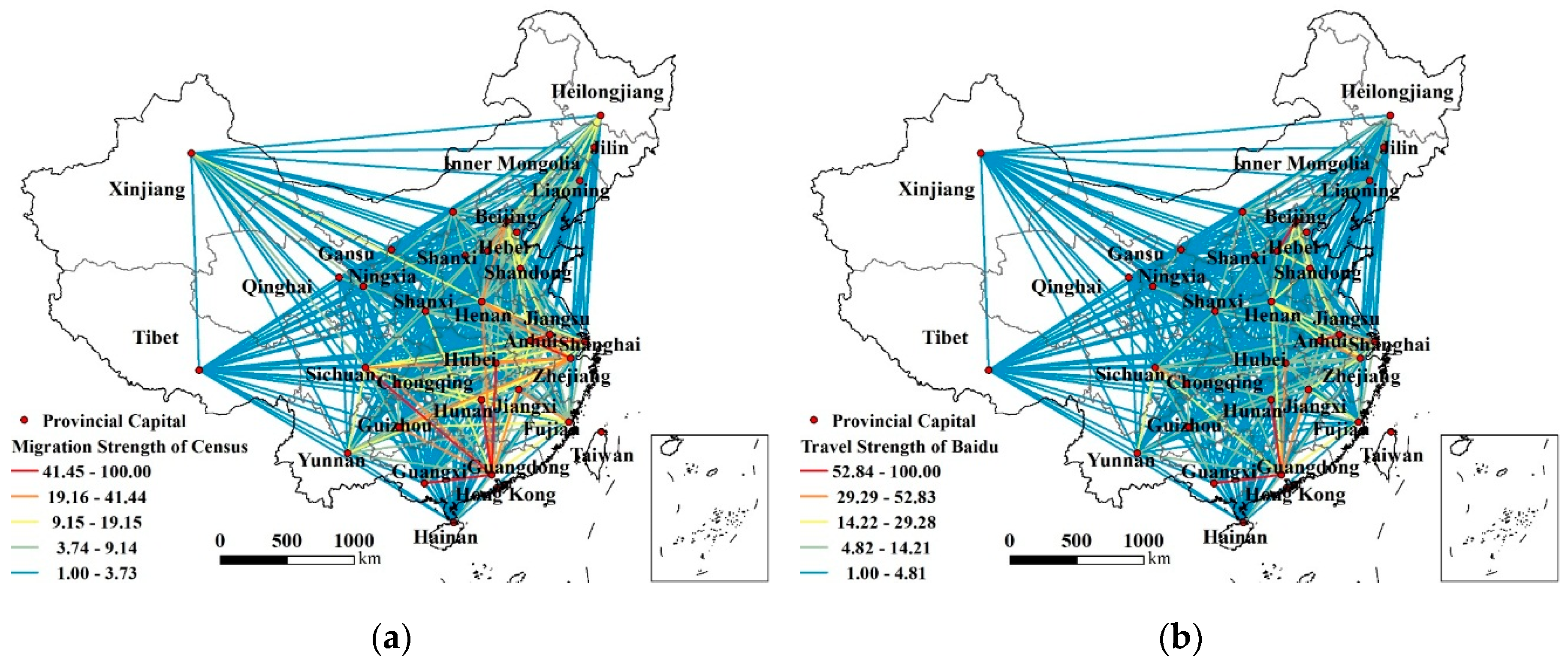
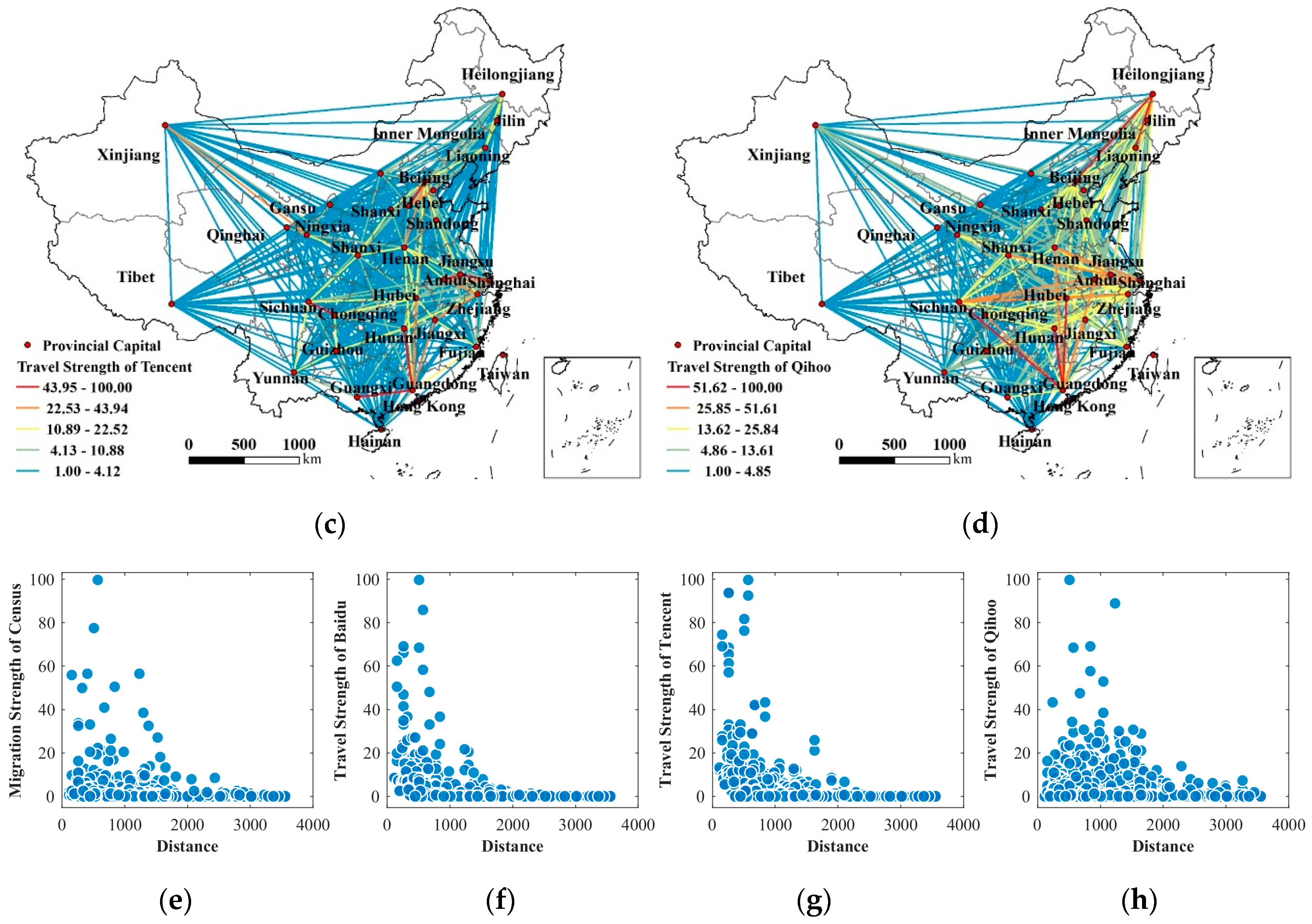
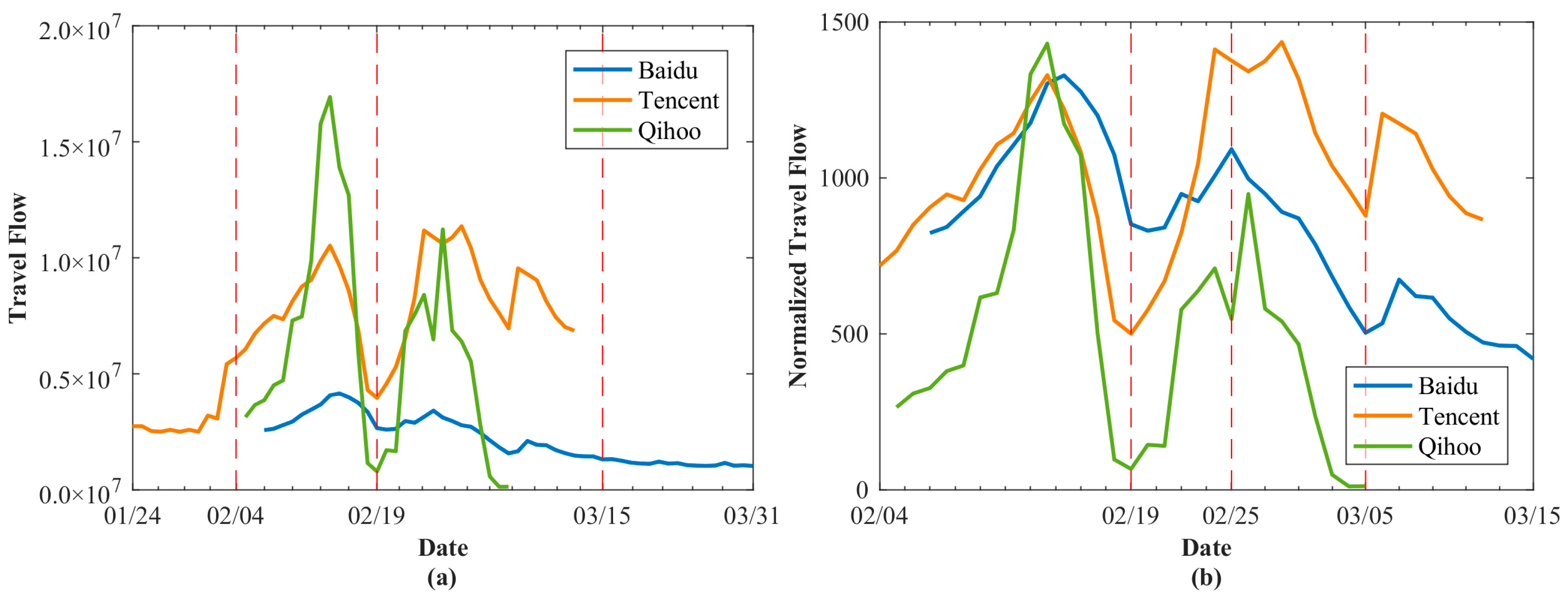
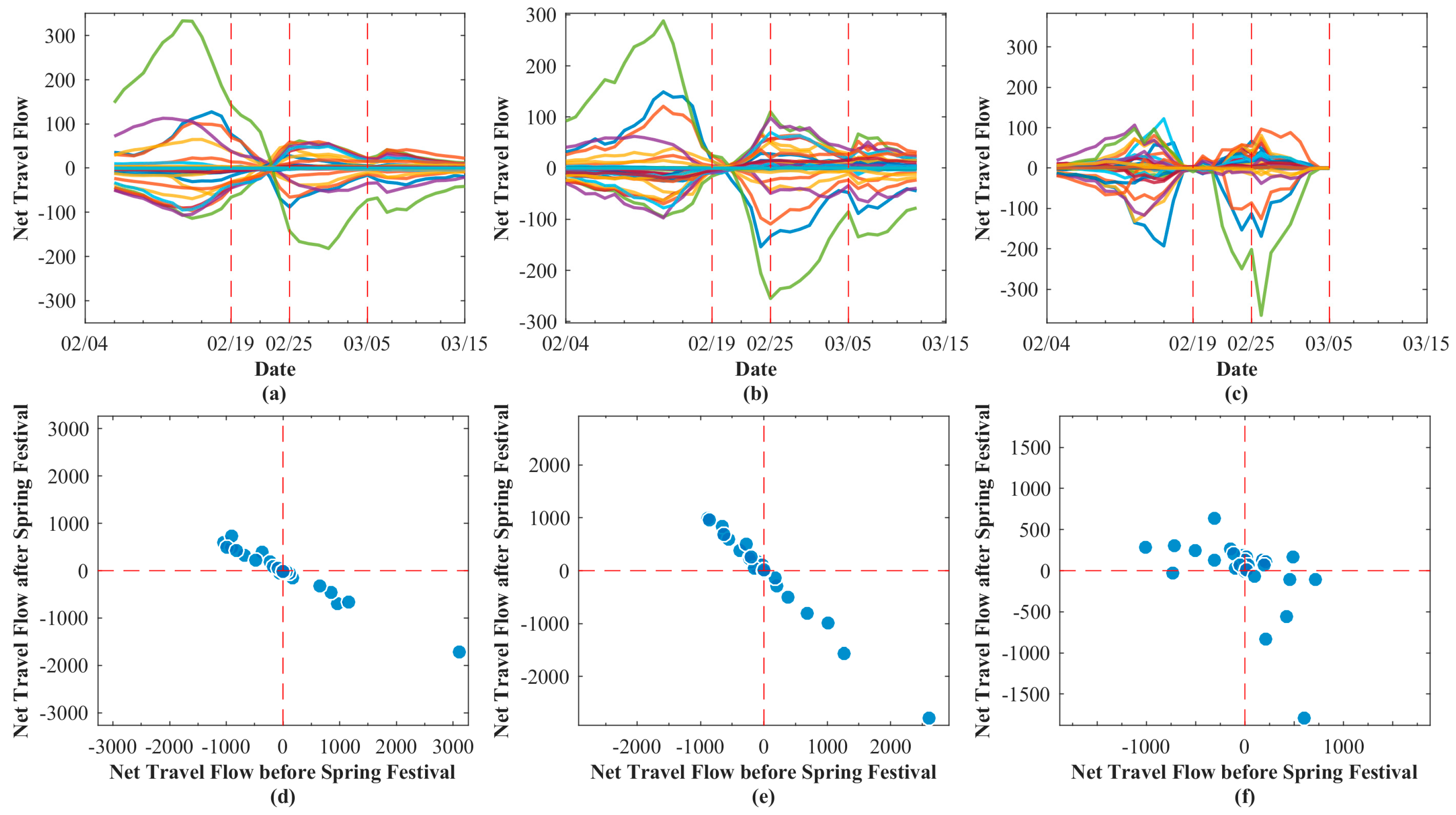
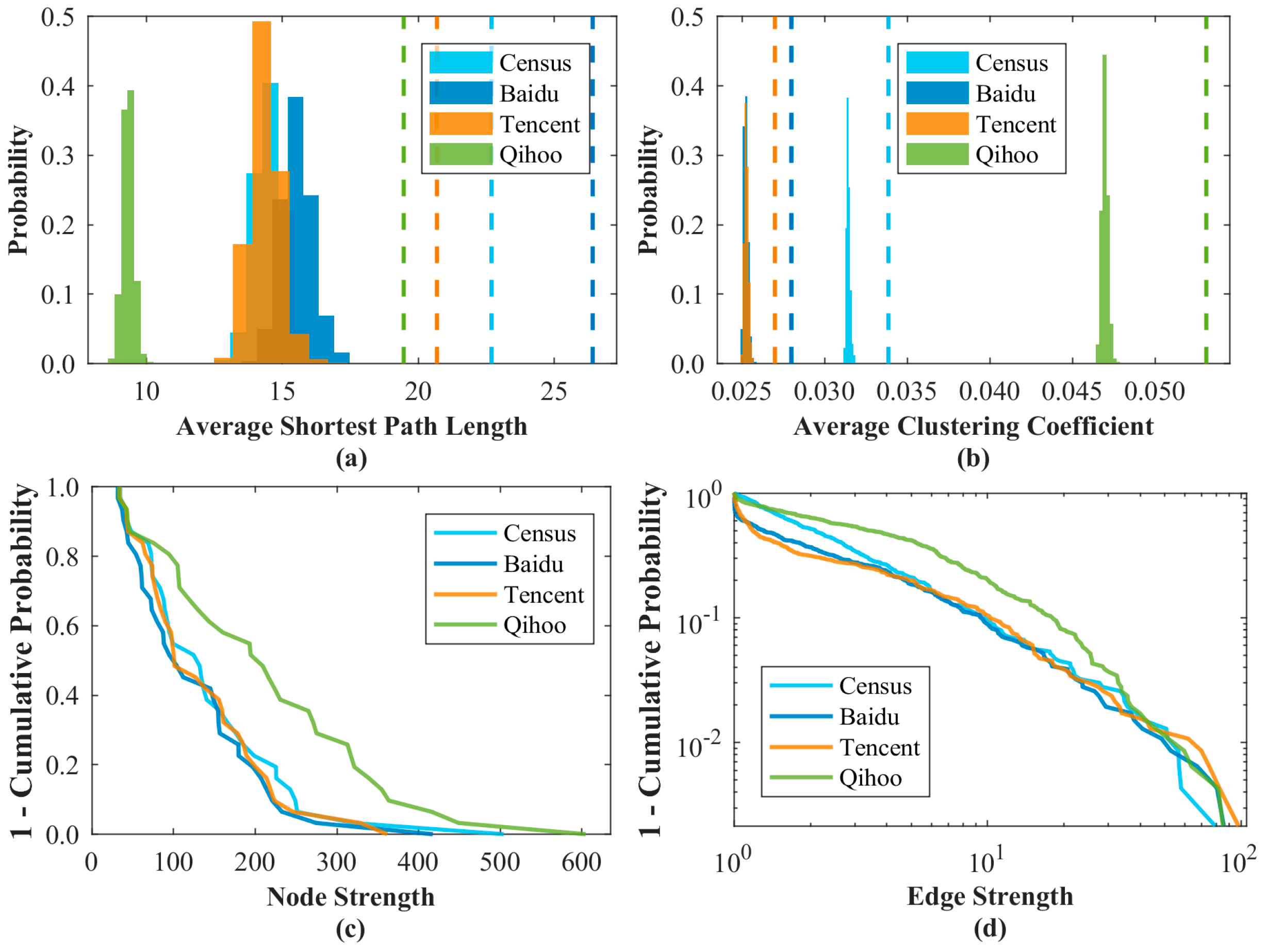
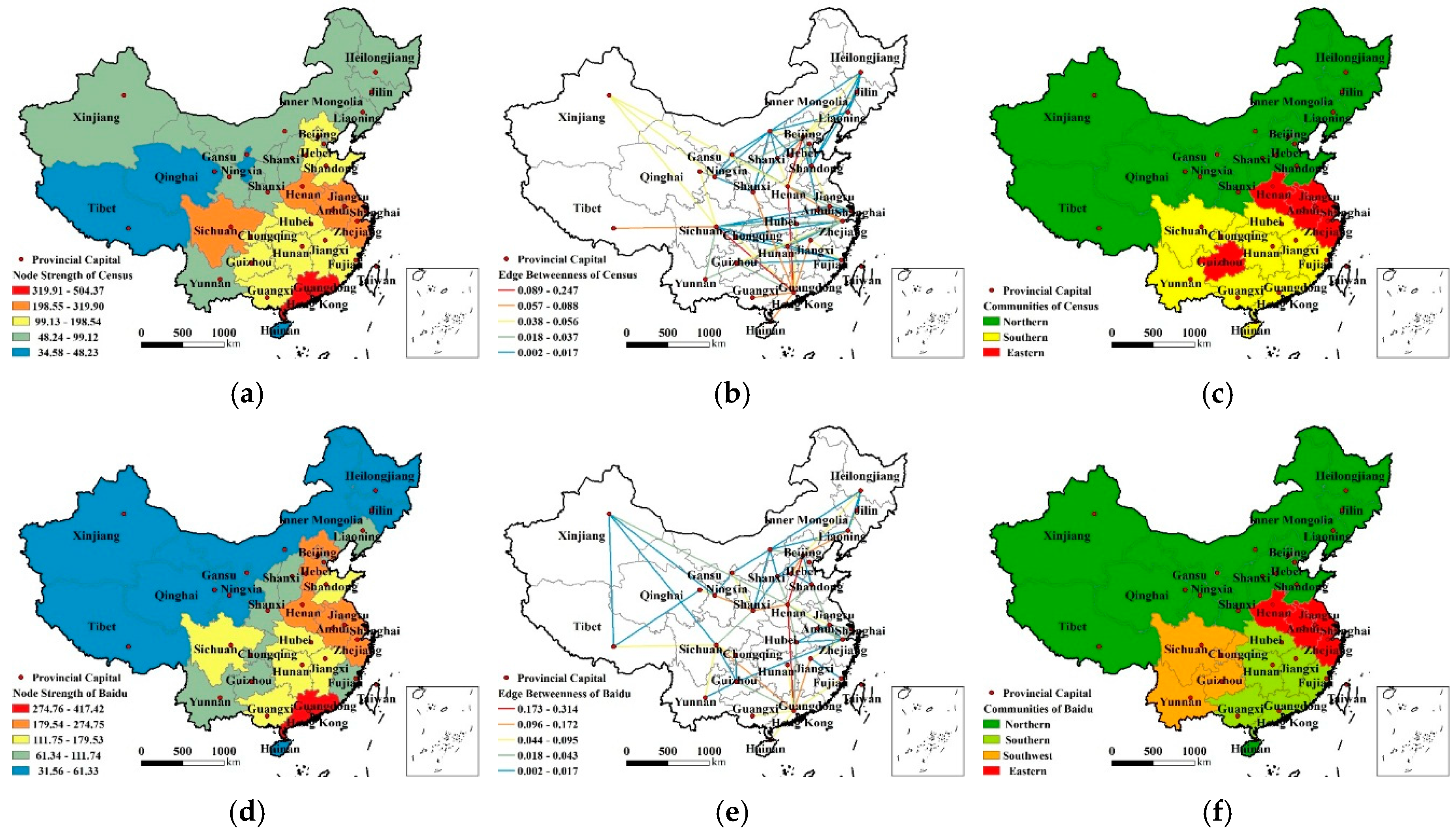
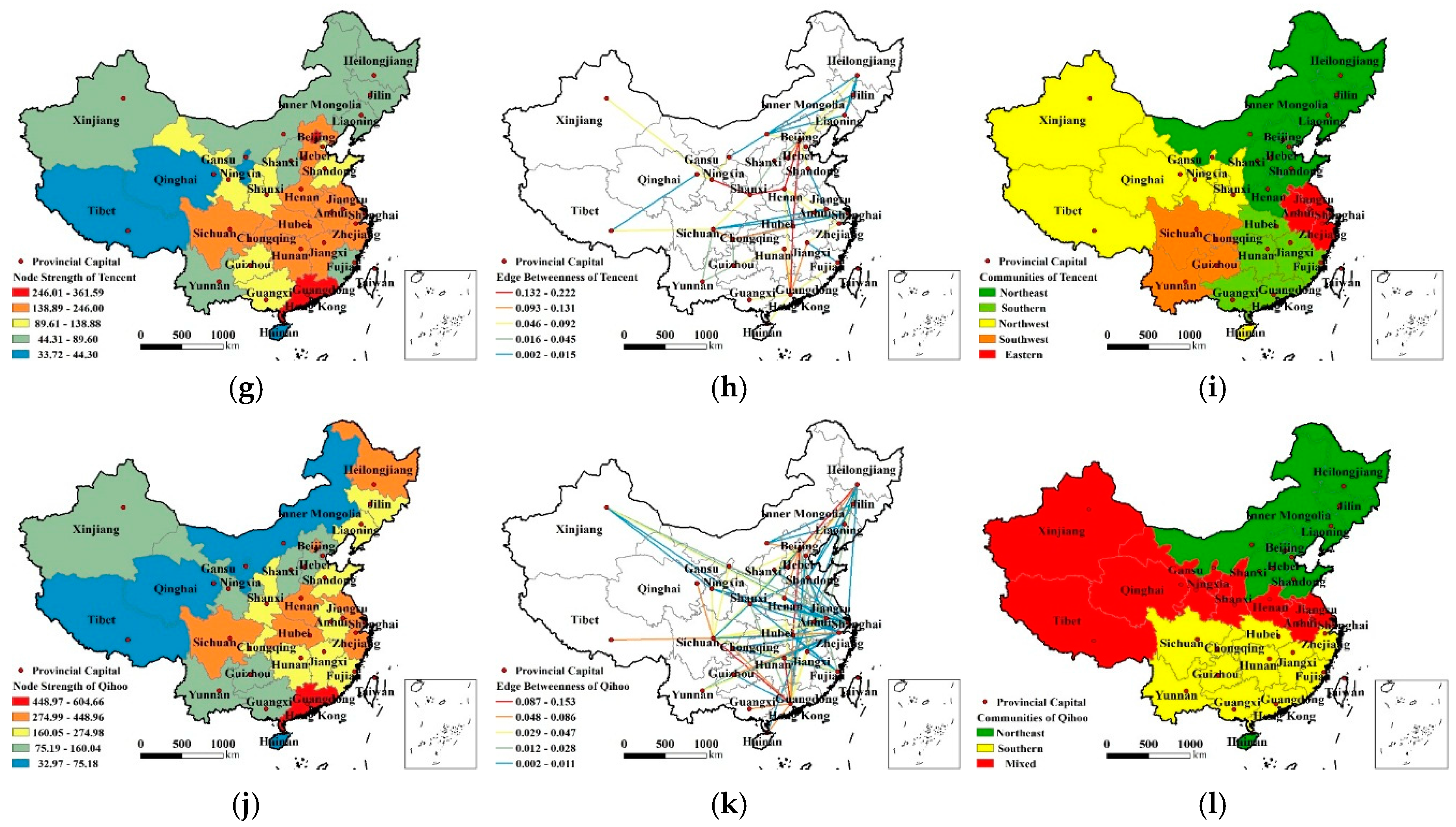

| Data Types | Baidu | Tencent | Qihoo |
|---|---|---|---|
| Data sources | Baidu LBS | Tencent LBS | automatic train ticket booking platform of Qihoo |
| Time range | 7 February 2015 to 31 March 2015 | 24 January 2015 to 12 March 2015 | 5 February 2015 to 5 March 2015 |
| Time resolution | Per hour | Per day | Per day |
| Space resolution | Cities and provinces | Cities | Provinces |
| Data size per collection | Top 4000 intercity flows; 369 cities’ top 10 inflows; 369 cities’ top 10 outflows; 34 provinces’ top 10 inflows; 34 provinces’ top 10 outflows (Not provide intercity travel data within a province.) | 365 cities’ top 10 inflows; 365 cities’ top 10 outflows | 31 provinces’ 31 inflows; 31 provinces’ 31 outflows |
| Linear/Logarithmic | Census | Baidu | Tencent | Qihoo |
|---|---|---|---|---|
| Census | 1.00/1.00 | 0.88/0.81 | 0.79/0.81 | 0.67/0.82 |
| Baidu | 1.00/1.00 | 0.95/0.82 | 0.49/0.66 | |
| Tencent | 1.00/1.00 | 0.46/0.70 | ||
| Qihoo | 1.00/1.00 |
| Ranking | Immigration | Emigration | ||||||
|---|---|---|---|---|---|---|---|---|
| Census | Baidu | Tencent | Qihoo | Census | Baidu | Tencent | Qihoo | |
| 1 | Guangdong | Guangdong | Guangdong | Guangdong | Anhui | Anhui | Anhui | Heilongjiang |
| 2 | Zhejiang | Zhejiang | Beijing | Beijing | Henan | Henan | Hunan | Hubei |
| 3 | Shanghai | Beijing | Shanghai | Zhejiang | Sichuan | Hunan | Henan | Sichuan |
| 4 | Beijing | Shanghai | Zhejiang | Shanghai | Hunan | Jiangxi | Guangxi | Henan |
| 5 | Jiangsu | Jiangsu | Jiangsu | Jiangsu | Jiangxi | Guangxi | Jiangxi | Chongqing |
| 6 | Tianjin | Tianjin | Tianjin | Xinjiang | Hubei | Hubei | Hubei | Jiangxi |
| 7 | Fujian | Fujian | Xinjiang | Tibet | Guangxi | Sichuan | Sichuan | Shanxi |
| 8 | Xinjiang | Xinjiang | Liaoning | — | Guizhou | Hebei | Hebei | Anhui |
| 9 | Liaoning | Qinghai | Tibet | — | Chongqing | Shandong | Shandong | Guangxi |
| 10 | Inner Mongolia | Ningxia | Qinghai | — | Hebei | Guizhou | Guizhou | Inner Mongolia |
© 2016 by the authors; licensee MDPI, Basel, Switzerland. This article is an open access article distributed under the terms and conditions of the Creative Commons Attribution (CC-BY) license (http://creativecommons.org/licenses/by/4.0/).
Share and Cite
Li, J.; Ye, Q.; Deng, X.; Liu, Y.; Liu, Y. Spatial-Temporal Analysis on Spring Festival Travel Rush in China Based on Multisource Big Data. Sustainability 2016, 8, 1184. https://doi.org/10.3390/su8111184
Li J, Ye Q, Deng X, Liu Y, Liu Y. Spatial-Temporal Analysis on Spring Festival Travel Rush in China Based on Multisource Big Data. Sustainability. 2016; 8(11):1184. https://doi.org/10.3390/su8111184
Chicago/Turabian StyleLi, Jiwei, Qingqing Ye, Xuankai Deng, Yaolin Liu, and Yanfang Liu. 2016. "Spatial-Temporal Analysis on Spring Festival Travel Rush in China Based on Multisource Big Data" Sustainability 8, no. 11: 1184. https://doi.org/10.3390/su8111184
APA StyleLi, J., Ye, Q., Deng, X., Liu, Y., & Liu, Y. (2016). Spatial-Temporal Analysis on Spring Festival Travel Rush in China Based on Multisource Big Data. Sustainability, 8(11), 1184. https://doi.org/10.3390/su8111184







